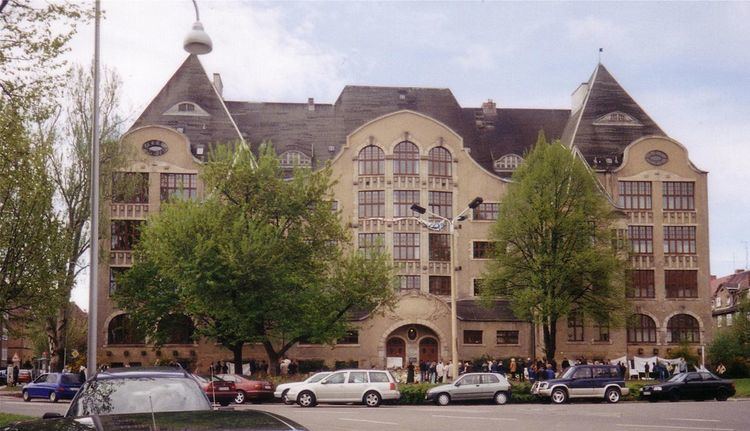Name Erfurt massacre | ||
 | ||
Coordinates 50°58′53″N 11°00′53″E / 50.98139°N 11.01472°E / 50.98139; 11.01472Coordinates: 50°58′53″N 11°00′53″E / 50.98139°N 11.01472°E / 50.98139; 11.01472 Date 26 April 2002c. 10:58 a.m. – c. 11:17 a.m. (CEST) Weapons Mossberg 590 Mariner 12-gauge pump-action shotgun9mm Glock 17C semiautomatic pistol | ||
Group from columbine visit erfurt massacre survivors
The Erfurt massacre was a school massacre that occurred on 26 April 2002 at the Gutenberg-Gymnasium in the Thuringia State capital Erfurt, Germany. (A German Gymnasium is a secondary school similar to a British Grammar school or a US Prep school.) The gunman, 19-year-old expelled student Robert Steinhäuser, shot and killed 16 people: 13 staff members, two students, and one police officer, before committing suicide. One person was also wounded by a bullet fragment.
Contents
- Group from columbine visit erfurt massacre survivors
- Sandbothe Erfurt Interview
- Background
- The massacre
- Reactions
- References
Sandbothe Erfurt Interview
Background

While the motive is unknown, media reports assumed it to be related to Steinhäuser's expulsion from school without qualifications and his subsequent feeling of victimhood and hopelessness regarding his future job opportunities.
Robert Steinhäuser (born 22 January 1983) was a student of the Gutenberg Gymnasium until early October 2001. At the end of September 2001 he had spent a few days away from school, for which he presented a mandatory medical certificate which was quickly identified as a forgery. Because of this forgery Steinhäuser was expelled.
Due to the regulations used in the State of Thuringia (German: Thüringen) at this time, Steinhäuser on expulsion found himself with no qualifications at all, and therefore very limited job prospects.
The massacre
On the day of the shooting, before leaving his residence at his usual time, Steinhäuser armed himself with a 9mm Glock 17 and a Mossberg 590 Mariner 12-gauge pump-action shotgun, which was unusable due to an earlier handling error. When he entered the campus, he went into the lavatories to change his clothes, and then donned a black ninja-style outfit.
The shooting started at approximately 10:58 a.m. Steinhäuser had moved from classroom to classroom, pausing briefly each time in the doorway to shoot the teacher, then moving on to the next room. According to students, he ignored them and aimed only for the teachers and administrators, although two students were killed by shots fired through a locked door.
Five minutes after the shooting began, police arrived outside the school. Soon after, Steinhäuser aimed from a window and fatally shot a police officer in the head. Before the shooter committed suicide, he was confronted by one of his teachers, Rainer Heise, who walked up to the demasking shooter. Pausing, having established eye-contact with Steinhäuser, he said, "Du kannst mich jetzt erschießen." ("You can shoot me now."), Steinhäuser is said to have answered, "Herr Heise, für heute reicht's" ("Mr. Heise, that's enough for today"). According to Heise, he then talked to Steinhäuser for a short period of time, luring him into the doorway of an empty room. When Steinhäuser was in the doorway, Heise pushed Steinhäuser into the room and quickly locked the door. Steinhäuser committed suicide shortly thereafter and his body was found by police a few hours after the shooting. 71 rounds were fired throughout the whole series of shootings.
Steinhäuser's last words – Für heute reicht's ("that's enough for today") – was also the title of a controversial book about the massacre written by Ines Geipel, who alleged that there were several mistakes made by the police on the case. Geipel, and relatives of some of the victims, criticized police for the initial speed of their response. The police had initially believed there was a second gunman, leading them to retake the school one floor at a time rather than storm the entire building.
Heise was hailed as a national hero for locking Steinhäuser in a room which ended the killing spree, but was later subject to backlash from some members of the public due to questions about his role. Erfurt Mayor Manfred Ruge said he fully believes Heise, but acknowledged the teacher's rather direct and animated style combined with the vast media coverage had caused resentment in the town.
The massacre led to the development of a code word that could be broadcast over the public address system to warn teachers of a shooting. "Mrs Koma is coming", which is "amok" spelled backwards, was later used at the Winnenden school shooting to alert teachers to that attack.
The gunman killed 16 people in the massacre—12 teachers, two students, one secretary, and one policeman.
Reactions
Steinhäuser's family issued a statement to news sources saying that they "will forever be sorry that our son and brother has brought such horrifying suffering to the victims and their relatives, the people of Erfurt and Thuringia, and all over Germany."
